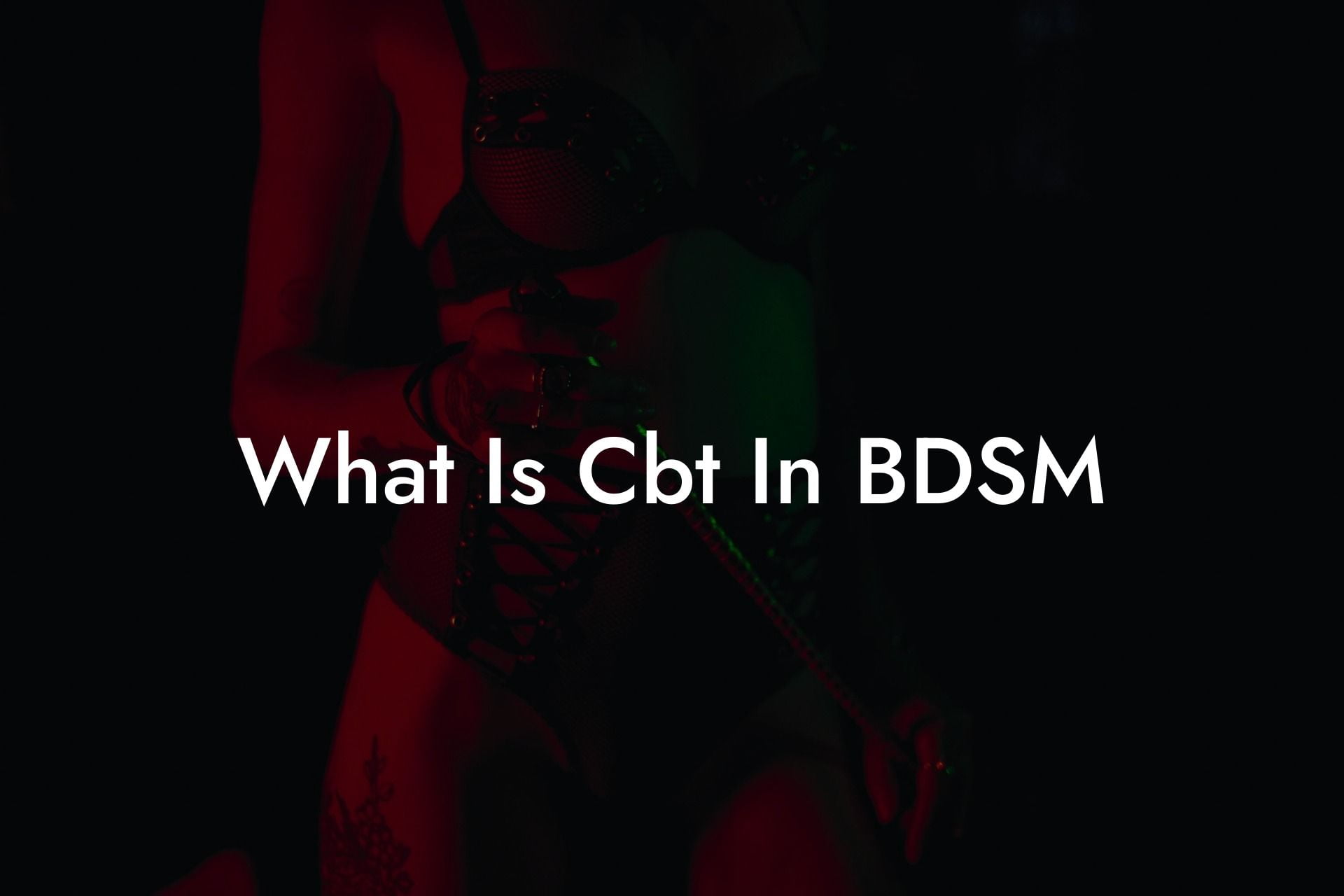What Is CBT In BDSM

Imagine a scene where every touch is charged with anticipation and every sensation is designed to push your boundaries, all while you’re fully in control of your pleasure. Welcome to the world of CBT in BDSM, where Cock and Ball Torture transforms vulnerability into an art form of consensual intensity. Whether you’re curious about this specific kink or have been exploring BDSM for years, CBT offers a unique blend of physical stimulation and psychological play that challenges your limits and empowers you to redefine what pleasure means on your own terms.
Quick Links to Useful Sections
- Understanding CBT in BDSM
- Defining CBT
- The History and Cultural Context of CBT
- From Taboo to Transformative Play
- Core Principles and Negotiation in CBT
- Consent and Communication
- Mutual Trust and Respect
- Techniques and Practices in CBT
- Common CBT Techniques
- Using BDSM Gear in CBT
- Psychological and Emotional Dimensions of CBT
- Exploring Vulnerability and Empowerment
- Emotional Catharsis Through Controlled Pain
- Aftercare in CBT
- The Importance of Aftercare
- Common Misconceptions About CBT
- Debunking Myths
- Real-Life Experiences and Testimonials
- Case Study: Emma’s Empowerment Through CBT
- Case Study: Ryan and Alex’s Trust-Building Experience
- Expert Insights: Guidance from the BDSM Community
- Words of Wisdom from Experienced Practitioners
- FAQ: Your “What Is CBT in BDSM” Questions Answered
Understanding CBT in BDSM
Defining CBT
CBT stands for Cock and Ball Torture, a term used in BDSM to describe activities that focus on the stimulation, restraint, and sometimes pain applied to the male genitals. This kink can range from mild teasing and light squeezing to more intense forms of impact or electrical stimulation. Although it may sound intimidating to some, CBT is practiced with strict adherence to consent, communication, and safety protocols.
For many participants, CBT is not simply about pain, it’s about the interplay between pleasure and discomfort, a way to explore power dynamics and trust through a carefully negotiated scene. In a consensual CBT session, the Dominant or rigger applies techniques that are both physically stimulating and psychologically arousing, ensuring that all activities are tailored to the boundaries and desires of the submissive partner.
The History and Cultural Context of CBT
From Taboo to Transformative Play
Like many BDSM practices, CBT has deep historical roots. Ancient texts and artworks hint at the exploration of pain and pleasure as intertwined experiences, and over centuries, these practices evolved into the modern kink we know today. Initially shrouded in secrecy and social taboo, CBT emerged from underground subcultures where it was practiced discreetly by those daring enough to explore the full spectrum of human sensation.
With the advent of the sexual revolution and greater societal acceptance of alternative lifestyles, CBT and other BDSM practices began to be discussed more openly. This cultural shift has transformed CBT from a hidden act of transgression into a consensual form of erotic play that many find empowering and transformative.
Core Principles and Negotiation in CBT
Consent and Communication
The foundation of any CBT scene is robust consent and clear communication. Before any play begins, all parties must engage in an in-depth discussion about limits, desires, and potential triggers. This dialogue includes agreeing on:
- Hard Limits: Specific activities that are completely off-limits.
- Soft Limits: Areas where caution is needed and that may be explored gradually.
- Safe Words/Signals: Pre-agreed words or gestures that can immediately pause or stop the scene if things become too intense.
- Aftercare Plans: Detailed strategies for physical and emotional support once the scene ends.
This negotiation process transforms CBT from a potentially risky endeavor into a safe, structured, and empowering exploration of erotic boundaries.
Mutual Trust and Respect
Trust is the heartbeat of any BDSM scene, especially in CBT where the focus is on the most sensitive parts of the body. The submissive entrusts their most vulnerable areas to the Dominant, who must always respect and safeguard that trust. This dynamic is built on mutual respect and constant check-ins to ensure that all activities remain within the agreed-upon boundaries.
When performed correctly, CBT not only heightens physical sensations but also deepens the emotional connection between partners, turning every act of surrender into a powerful expression of trust.
Looking for the best BDSM & Kink OnlyFans content creators? Check out these UNBELIEVABLE OnlyFans Creators:
-
-
-
- Best Slutty Asian Cosplay OnlyFans → 🥵 Shadow Kitsune → View Pictures & Videos
- Best Solo & Dildo Play OnlyFans Creator → 🌹 Lexy , Your Fifty Shades of Fantasy 🌹 → View Pictures & Videos
- Best Filthy Teen Brat & Girlfriend Experience OnlyFans Creator → 💋 Alexa – Your Shy & Wild Girlfriend 💋 → View Pictures & Videos
- Best Slutty Submissive British Blonde OnlyFans Creator → Sofia 🧚 → View Pictures & Videos
- Best Anal, Sexting & Dick Rating OnlyFans Creator → Sofia💕 → View Pictures & Videos
- Best Hot Asian & Latina Mixed OnlyFans Creator → 🍑 Miso Lexii - Half Latina / Half Asian 👅 → View Pictures & Videos
-
-
Techniques and Practices in CBT
Common CBT Techniques
CBT encompasses a variety of techniques that can range from light teasing to more intense stimulation. Some common methods include:
- Squeezing and Pinching: Using fingers or specialized tools to apply controlled pressure to the penis and testicles.
- Impact Play: Utilizing paddles, floggers, or slappers specifically designed for sensitive areas, creating a mix of pain and pleasure.
- Strapping and Binding: Employing bondage techniques to restrict movement and enhance the sensation of helplessness, which can intensify the overall experience.
- Temperature Play: Alternating between cold (such as ice cubes) and warmth (like heating pads) to stimulate the nerve endings in unique ways.
- Electrical Stimulation: Using devices designed for erotic electrostimulation to produce tingling sensations, adding an extra dimension of thrill.
Each of these techniques can be adjusted to suit individual preferences, ensuring that the experience is as gentle or as intense as desired.
Using BDSM Gear in CBT
The right gear can enhance a CBT session significantly. Specialized equipment might include:
- Adjustable Clamps: Designed to apply consistent pressure without causing injury, these clamps are often adjustable to fit comfortably.
- Bondage Ropes and Straps: Used to secure the genitals in place, allowing for controlled restraint and enhanced sensitivity.
- Impact Tools: Paddles, whips, or floggers that are specifically tailored for use on delicate areas can help create a varied range of sensations.
- Temperature Play Tools: Items such as ice cubes or warming devices that can safely interact with the skin, enhancing the sensory experience.
When using gear, safety and hygiene are paramount. All equipment should be kept clean and well-maintained, and its use should always be preceded by thorough communication about comfort levels.
Psychological and Emotional Dimensions of CBT
Exploring Vulnerability and Empowerment
The appeal of CBT extends beyond physical stimulation, it is also a profound psychological experience. For many, engaging in CBT allows them to confront and embrace their vulnerability. The act of surrendering control over such an intimate area can be cathartic, transforming fear or anxiety into a deep sense of release and empowerment.
For Dominants, guiding a CBT session with care and precision can reinforce their sense of responsibility and control, ultimately deepening the mutual trust and intimacy between partners. The interplay of pain, pleasure, and surrender in CBT creates an emotionally charged environment where both parties can experience personal growth.
Emotional Catharsis Through Controlled Pain
Many participants in CBT find that the controlled application of pain can lead to a powerful emotional catharsis. The release of endorphins triggered by these sensations not only elevates physical arousal but can also help dissipate emotional tension. This catharsis often results in feelings of euphoria and a renewed sense of self-awareness.
The key to this process is the consensual nature of the play, knowing that every moment is negotiated and that you can communicate your needs at any time transforms what might be overwhelming into an experience of deep, shared liberation.
Aftercare in CBT
The Importance of Aftercare
Given the intensity of CBT, aftercare is absolutely essential. Aftercare is the process of caring for each other once the scene concludes, helping to transition from the heightened state of play back to everyday life. In CBT, aftercare may involve:
- Physical Comfort: Gentle massages, warm blankets, and hydration help soothe any physical discomfort caused by prolonged stimulation or restraint.
- Emotional Reassurance: Open and supportive conversations allow both partners to process the experience and reaffirm their trust and connection.
- Time to Reflect: Whether through shared debriefing or individual reflection, aftercare provides the space needed to integrate the intense sensations and emotions of the scene.
Effective aftercare ensures that every participant feels valued and secure, reinforcing the foundation of trust that makes CBT and other BDSM practices safe and empowering.
Common Misconceptions About CBT
Debunking Myths
Despite its prevalence in BDSM circles, CBT is often misunderstood. Some common misconceptions include the ideas that it is purely about inflicting pain or that it is inherently abusive. In reality, CBT is a consensual form of erotic play where every action is negotiated in advance. Its primary goal is to explore the boundaries between pleasure and discomfort in a safe, controlled environment. The use of safe words, continuous communication, and thorough aftercare ensures that CBT remains a mutually empowering experience rather than an act of harm.
By debunking these myths, practitioners and educators alike work to promote a more accurate and respectful understanding of CBT as a valid and transformative aspect of BDSM.
Real-Life Experiences and Testimonials
Case Study: Emma’s Empowerment Through CBT
Emma, a seasoned participant in the BDSM community, shares her journey of self-discovery through CBT. Initially, the thought of engaging in CBT was both thrilling and daunting. Through clear, respectful negotiations with her Dominant and a carefully structured scene, Emma learned to embrace the sensations and the vulnerability that came with CBT. Over time, she experienced an emotional catharsis that not only enhanced her physical pleasure but also boosted her self-confidence and deepened her trust in her partner. Emma’s story is a testament to how CBT, when practiced consensually, can be a powerful tool for personal empowerment and emotional healing.
Case Study: Ryan and Alex’s Trust-Building Experience
Ryan and Alex, a couple who regularly incorporate CBT into their play, credit their deepened emotional connection to the trust and communication required for such intense scenes. By negotiating every detail, from safe words to aftercare protocols, they have created a secure environment that allows them to explore CBT fully. Their shared experience of navigating the fine line between pain and pleasure has not only enriched their sexual encounters but also fostered a bond built on mutual respect and continuous growth.
Their dynamic serves as an inspiring example of how CBT can be integrated into a healthy BDSM relationship, reinforcing that the practice is as much about emotional connection as it is about physical sensation.
Expert Insights: Guidance from the BDSM Community
Words of Wisdom from Experienced Practitioners
Veteran Dominant Marcus Steele advises, “CBT is an art of controlled intensity. With clear communication and unwavering consent, it can transform vulnerability into a powerful expression of desire and trust.”
Looking for the best BDSM & Kink OnlyFans content creators? Check out these UNBELIEVABLE OnlyFans Creators:
-
-
-
- Best Slutty Asian Cosplay OnlyFans → 🥵 Shadow Kitsune → View Pictures & Videos
- Best Solo & Dildo Play OnlyFans Creator → 🌹 Lexy , Your Fifty Shades of Fantasy 🌹 → View Pictures & Videos
- Best Filthy Teen Brat & Girlfriend Experience OnlyFans Creator → 💋 Alexa – Your Shy & Wild Girlfriend 💋 → View Pictures & Videos
- Best Slutty Submissive British Blonde OnlyFans Creator → Sofia 🧚 → View Pictures & Videos
- Best Anal, Sexting & Dick Rating OnlyFans Creator → Sofia💕 → View Pictures & Videos
- Best Hot Asian & Latina Mixed OnlyFans Creator → 🍑 Miso Lexii - Half Latina / Half Asian 👅 → View Pictures & Videos
-
-
BDSM educator Fiona Rivera adds, “Engaging in CBT requires deep self-awareness and mutual respect. When practiced safely and consensually, it allows both partners to explore the interplay between pain and pleasure, ultimately leading to a profound sense of empowerment and emotional release.”
FAQ: Your “What Is CBT in BDSM” Questions Answered
1. What does CBT stand for in BDSM?
CBT stands for Cock and Ball Torture, a form of BDSM play that focuses on the stimulation, restraint, and sometimes pain of the male genitals, all within a framework of consensual power exchange.
2. What kinds of activities are involved in CBT?
CBT activities can include squeezing, pinching, impact play with tools like paddles or whips, bondage, temperature play (using ice or heat), and even electrical stimulation, all tailored to the comfort and consent of the participants.
3. Is CBT only about pain?
No, CBT is not solely about pain. It is about exploring the boundaries between pain and pleasure, and many find that the sensations involved lead to intense arousal and emotional catharsis.
4. How important is consent in CBT?
Consent is absolutely critical in CBT. All activities are thoroughly negotiated in advance with clear boundaries and safe words, ensuring that every action is fully consensual.
5. What safety measures should be taken during a CBT session?
Key safety measures include detailed pre-scene negotiations, using safe words or signals to immediately halt the activity if necessary, continuous monitoring of physical and emotional reactions, and providing comprehensive aftercare.
6. Can CBT be tailored to different comfort levels?
Yes, CBT is highly customizable. The intensity and specific techniques used can be adjusted to fit the individual preferences and limits of the participants.
7. What is the role of BDSM gear in CBT?
Specialized gear, such as adjustable clamps, bondage straps, and impact tools, is often used in CBT to safely apply stimulation. The gear enhances the physical sensations and reinforces the power dynamics inherent in the scene.
8. How does CBT contribute to emotional catharsis?
The intense sensations and controlled vulnerability in CBT can lead to a release of pent-up emotions, often resulting in a powerful emotional catharsis that promotes self-awareness and empowerment.
9. Can CBT be a part of a long-term BDSM relationship?
Absolutely. Many couples incorporate CBT into their regular play as a way to explore their boundaries and deepen their trust and intimacy over time.
10. Where can I learn more about CBT in BDSM?
You can learn more from reputable resources such as "SM 101: A Realistic Introduction," online communities like FetLife and Reddit’s r/BDSM, podcasts such as "Kink Academy," and workshops or seminars focused on safe, consensual BDSM practices.
Resources and Community Support: Your Next Steps in Exploring CBT in BDSM
- FetLife: Connect with experienced practitioners and communities to share your experiences and learn more about safe CBT practices.
- Reddit: Engage with subreddits such as r/BDSM to read personal accounts and gather tips on exploring CBT.
- BDSM Literature: Read books like "SM 101: A Realistic Introduction" for comprehensive insights into the principles and practices of BDSM, including CBT.
- Podcasts and Videos: Listen to "Kink Academy" and watch tutorials for expert guidance on negotiating, practicing, and aftercare for CBT scenes.
- Workshops and Seminars: Attend events and local meetups to deepen your knowledge and connect with like-minded individuals who prioritize safe, consensual play.
CBT in BDSM is a dynamic exploration of the boundaries between pain and pleasure, a consensual practice that transforms vulnerability into empowerment. With clear communication, strict safety protocols, and comprehensive aftercare, CBT offers a pathway to profound physical and emotional release that can enhance your understanding of desire and deepen your intimate connections.
Looking for the best BDSM & Kink OnlyFans content creators? Check out these UNBELIEVABLE OnlyFans Creators:
-
-
-
- Best Slutty Asian Cosplay OnlyFans → 🥵 Shadow Kitsune → View Pictures & Videos
- Best Solo & Dildo Play OnlyFans Creator → 🌹 Lexy , Your Fifty Shades of Fantasy 🌹 → View Pictures & Videos
- Best Filthy Teen Brat & Girlfriend Experience OnlyFans Creator → 💋 Alexa – Your Shy & Wild Girlfriend 💋 → View Pictures & Videos
- Best Slutty Submissive British Blonde OnlyFans Creator → Sofia 🧚 → View Pictures & Videos
- Best Anal, Sexting & Dick Rating OnlyFans Creator → Sofia💕 → View Pictures & Videos
- Best Hot Asian & Latina Mixed OnlyFans Creator → 🍑 Miso Lexii - Half Latina / Half Asian 👅 → View Pictures & Videos
-
-

 Fuck Each Other Not The Planet Unisex
Fuck Each Other Not The Planet Unisex Wear My Kink
Wear My Kink